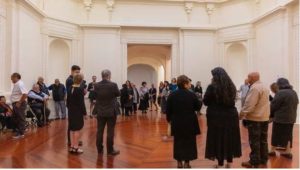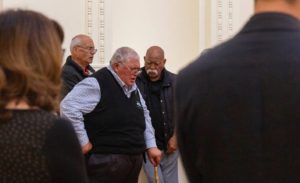03 Dec Whanganui’s Sarjeant Gallery: Blessing for redevelopment to move forward
By Gaye Batty, Project Director at the Sarjeant Gallery.

About 30 people gathered for the blessing of the Sarjeant Gallery redevelopment.
The Sarjeant Gallery has been blessed, and blessings given by mana whenua for the redevelopment project to move forward into the next phase.
Members of Te Runanga o Tūpoho, invited guests and gallery staff met early on Monday November 25 to bless the exterior and interior and signal the path is open for work to begin.
The redevelopment involves refurbishing and seismic strengthening the 100-year-old building and constructing a new wing to house new exhibition spaces, a retail shop, cafe, education studio and a state-of-the-art storage space for the Sarjeant Gallery’s nationally significant art collection.
The extension will be named Pataka o Sir Te Atawhai Archie John Taiaroa, dedicated to Sir Te Atawhai Archie John Taiaroa, who was a loved and respected kaumātua and an inspirational leader of the Whanganui people.
Te Aranga design principles have been used in the scoping and concept design phases, enabling Māori values to be integrated into the design process and improved awareness and engagement with mana whenua on this site of cultural significance.
Derived from the 2006 Te Aranga Māori Cultural Landscapes Strategy, the design principles were developed with input from iwi around Aotearoa New Zealand including Whanganui/Tūpohō.
The principles include recognition and respect of iwi and hapū as mana whenua, our natural environment, environmental health, creative expression, and cultural landscape.
The site occupied by the Sarjeant Gallery, Pukenamu Queen’s Park, is Whanganui City’s major high point on the right bank of the Whanganui River.
It has great historical importance and high archaeological value, first as part of a fortified pa site known as Pukenamu, and later when set aside as reserve land in the early town plan for Whanganui.
The site has cultural significance and history to Te Runanga o Tūpoho. A cultural impact assessment is in development so that future management of the site can take cultural considerations properly into account and to inform the archaeological process for the treatment of findings unearthed on the site during the excavation phase.

Kaumātua o Whanganui iwi – Gavin Brooks, John Maihi and Joe Taiaroa led the blessing of the Sarjeant Gallery.
In keeping with the principles, a communication programme is in development to ensure engagement with Te Runanga is effective throughout all phases of the redevelopment project.
Upcoming matters for kōrero discussion include the burial of a mauri stone, site monitoring during excavation, design and creation of ornamentation and artwork for the extension wing, planning and transfer of artwork from the current premises on Taupō Quay to the new gallery archive, and the opening event planning.
Click here to see the origianl article at newzealandherald.co.nz

